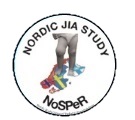About JIA
JIA, juvenile idiopathic arthritis, is a chronic disease with persistent inflammation of one or more joints. Signs are pain and swelling of the joint and often limitation of movement. ‘Idiopathic’ means that the exact cause of the disease is still unknown and ‘juvenile’ that symptoms appear before the age of 16 years. JIA is an entity of diseases and it is further divided into 7 categories according to specific disease characteristics.
- Oligoarthritis: Arthritis affecting 1-4 joints during the first 6 months of disease
Two subcategories of oligoarthritis are recognized:
1. Persistent oligoarthritis: Affecting not more than 4 joints throughout the disease course
2. Extended oligoarthritis: Affecting a total of more than 4 joints after the first 6 months of disease
- Seronegative polyarthritis, Rheumatoid Factor (RF) negative: Arthritis affecting 5 or more joints during the first 6 months of disease; a test for RF is negative
- Seropositive polyarthritis, RF positive: Arthritis affecting 5 or more joints during the first 6 months of disease, RF is positive (adult type)
- Systemic (Still’s disease): Quoting fever for at least 2 weeks including other symptoms like rash and arthritis
- Enthesitis related: Arthritis with enthesitis (HLA-B27 antigen often present)
- Psoriatic: Arthritis with psoriasis (or arthritis and psoriasis in a 1-degree relative)
- Other: Arthritis that does not fulfill criteria for any other category or fulfills criteria for more than one of them
